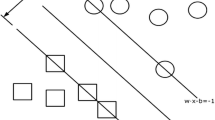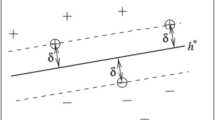Abstract
Support vector regression (SVR) method is a novel type of learning machine algorithms, which is seldom applied to the development of urban atmospheric quality models under multiple socio-economic factors. This study presents four SVR models by selecting linear, radial basis, spline, and polynomial functions as kernels, respectively for the prediction of urban dust fall levels. The inputs of the models are identified as industrial coal consumption, population density, traffic flow coefficient, and shopping density coefficient. The training and testing results show that the SVR model with radial basis kernel performs better than the other three both in the training and testing processes. In addition, a number of scenario analyses reveal that the most suitable parameters (insensitive loss function ɛ, the parameter to reduce the influence of error C, and discrete level or average distribution of parameters σ) are 0.001, 0.5, and 2 000, respectively.
Similar content being viewed by others
References
HUANG Guo-he. Stepwise cluster analysis method for predicting air quality in an urban environment [J]. Atmos Environ, 1992, 26(3): 349–357.
RUSSELL A G, WINNER D A, HARLEY R A, MCCUE K F, CASS G R. Mathematical modeling and control of the dry deposition flux of nitrogen-containing air pollutants [J]. Environ Sci Technol, 1993, 27(13): 2772–2782.
LU Hong-wei, HUANG Guo-he, LIU Lei, HE Li. An interval-parameter fuzzy-stochastic programming approach for air quality management under uncertainty [J]. Environmental Engineering Science, 2008, 25(6): 895–909.
LU Hong-wei, HUANG Guo-he, LIU Zhen-fang, HE Li. Greenhouse gas mitigation-induced rough-interval programming for municipal solid waste management [J]. J Air Waste Manage Assoc, 2008, 58(12): 1546–1559.
LU Hong-wei, HUANG Guo-he, LIU Zhen-fang, HE Li, ZENG Guang-ming. An inexact dynamic optimization model for municipal solid waste management in association with greenhouse gas emission control [J]. J Environ Manage, 2009, 90(1): 396–409.
HE Li, HUANG Guo-he, LU Hong-wei, ZENG Guang-ming. Wavelet-based multiresolution analysis technique for data cleaning and its application to water quality management system [J]. Expert Systems with Applications, 2008, 35(3): 1301–1310.
HE Li, HUANG Guo-he, LU Hong-wei, ZENG Guang-ming. Optimization of surfactant-enhanced aquifer remediation for a laboratory BTEX system under parameter uncertainty [J]. Environ Sci Technol, 2008, 42(6): 2009–2014.
HE Li, HUANG Guo-he, LU Hong-wei. Health-risk-based groundwater remediation system optimization through clusterwise linear regression [J]. Environ Sci Technol, 2008, 42(24): 9237–9243.
HE Li, HUANG Guo-he, LU Hong-wei, ZENG Guang-ming. An integrated simulation, inference, and optimization method for identifying groundwater remediation strategies at petroleum-contaminated aquifers in western Canada [J]. Water Research, 2008, 42(10/11): 2629–2639.
SHIVELY T S, SAGER T W. Semiparametric regression approach to adjusting for meteorological variables in air pollution trends [J]. Environ Sci Technol, 1999, 33(21): 3873–3880.
PODNAR D, KORACIN D, PANORSKA A. Application of artificial neural networks to modeling the transport and dispersion of tracers in complex terrain [J]. Atmos Environ, 2002, 36: 561–570.
PEREZ P, REYES J. An integrated neural network model for PM10 forecasting [J]. Atmos Environ, 2006, 40: 2845–2851.
GÓMEZ-SANCHIS J, MARTIN-GUERRERO J D, SORIA-OLIVAS E, VILA-FRANCES J, CARRASCO J L, VALLE-TASCON S D. Neural networks for analyzing the relevance of input variables in the prediction of tropospheric ozone concentration [J]. Atmos Environ, 2006, 40: 6173–6180.
PAI P F, HONG W C. Forecasting regional electricity load based on recurrent support vector machines with genetic algorithms [J]. Electric Power Systems Research, 2005, 74: 417–425.
VAPNIK V, GOLOWICH S, SMOLA A. Support vector machine for function approximation, regression estimation, and signal processing [J]. Adv Neural Inf Process Syst, 1996(9): 281–287.
ASEFA T, KEMBLOWSKI M, URROZ G, MCKEE M, KHALIL A. Support vectors-based groundwater head observation networks design [J]. Water Resour Res, 2004, 40(11): 1–10.
LU W Z, WANG W J. Potential assessment of the “support vector machine” method in forecasting ambient air pollutant trends [J]. Chemosphere, 2005, 59: 693–701.
SUN S. Principal component analysis of air pollutant sources in Xiamen, China [J]. China Envir Sci, 1989, 10: 23–41.
HE L, CHAN C W, HUANG G H, ZENG G M. A probabilistic reasoning-based decision support system for selecting remediation technologies for petroleum-contaminated sites [J]. Expert Systems with Applications, 2006, 30(4): 783–795.
CORTES C, VAPNIK V. Support vector networks [J]. Machine Learning, 1995, 20: 273–297.
KHALIL A, ALMASRI M N, MCKEE M, KALUARACHCHI J J. Applicability of statistical learning algorithms in groundwater quality modeling [J]. Water Resour Res, 2005, 41: 1–16.
YUE W, LI X, LIU J, LI Y, YU X, DENG B. Characterization of PM2.5 in the ambient air of Shanghai city by analyzing individual particles [J]. Sci Total Environ, 2006, 368: 916–925.
CHALOULAKOU A, SAISANA M, SPYRELLIS N. Comparative assessment of neural networks and regression models for forecasting summertime ozone in Athens [J]. Sci Total Environ, 2003, 313: 1–13.
SAHOO G B, RAY C, MEHNERT E, KEEFER D A. Application of artificial neural networks to assess pesticide contamination in shallow groundwater [J]. Sci Total Environ, 2006, 367: 234–251.
ELGAALI E, GARCIALA. Using neural networks to model the impacts of climate change on water supplies [J]. J Water Res Pl.-ASCE, 2007, 133(3): 230–243.
GOYAL P, CHAN A T, JAISWAL N. Statistical models for the prediction of respirable suspended particulate matter in urban cities [J]. Atmos Environ, 2006, 40: 2068–2077.
HANRAHAN G, GARZA C, GARCIA E, MILLER K. Experimental design and response surface modeling: A method development application for the determination of reduced inorganic species in environmental samples [J]. Journal of Environmental Informatics, 2007, 9(2): 71–79.
Author information
Authors and Affiliations
Corresponding author
Additional information
Foundation item: Projects(2007JT3018, 2008JT1013, 2009FJ4056) supported by the Key Project in Hunan Science and Technology Program, China; Project(20090161120014) supported by the New Teachers Sustentation Fund in Doctoral Program, Ministry of Education, China
Rights and permissions
About this article
Cite this article
Jiao, S., Zeng, Gm., He, L. et al. Prediction of dust fall concentrations in urban atmospheric environment through support vector regression. J. Cent. South Univ. Technol. 17, 307–315 (2010). https://doi.org/10.1007/s11771-010-0047-x
Received:
Accepted:
Published:
Issue Date:
DOI: https://doi.org/10.1007/s11771-010-0047-x




